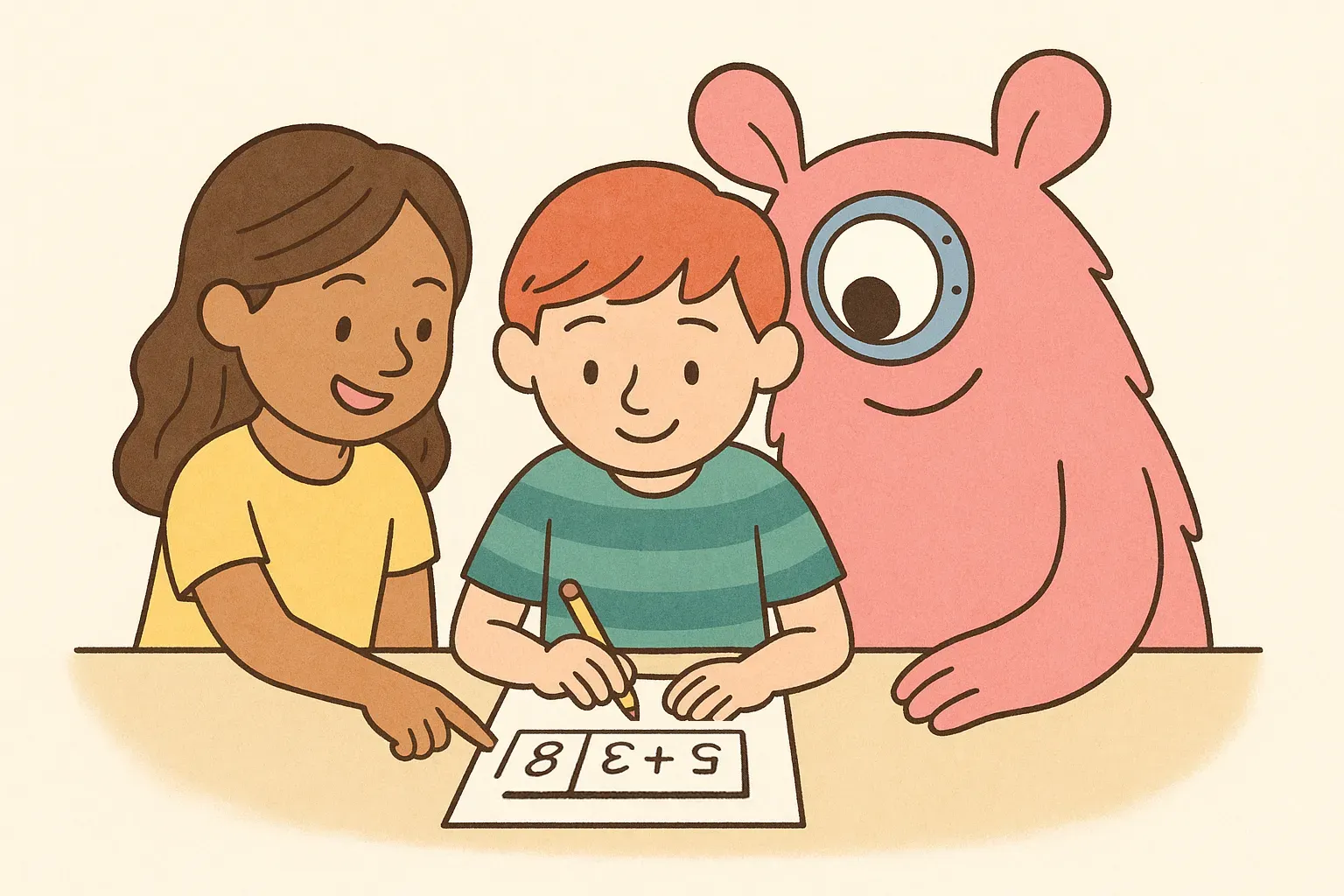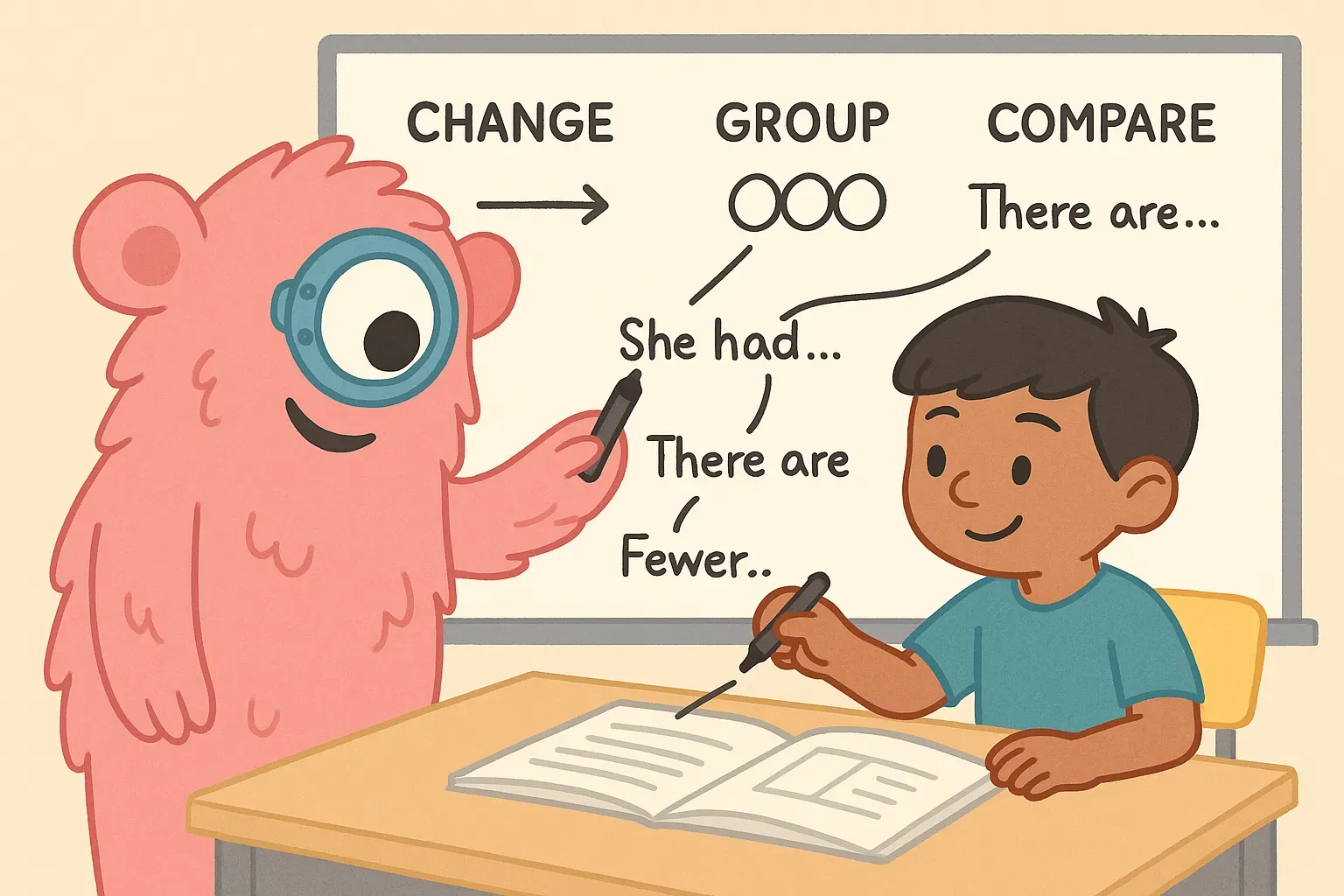10 Inclusive Math Teaching Strategies That Support All Learners
TL;DR
Supporting neurodivergent elementary students in math can be achieved through research-backed strategies that promote inclusion and engagement. Key approaches include using manipulatives for hands-on learning, visual aids like color-coding, structured routines, technology integration, schema-based problem-solving, peer collaboration, flexible pacing, real-world applications, multisensory methods, and systematic practice. These methods, drawn from peer-reviewed studies, help build confidence and skills for all learners, including those with ADHD, autism, or dyslexia.
As parents of elementary school children in the US, especially those with neurodivergent traits like ADHD, autism, or dyslexia, you may wonder how to make math accessible and enjoyable. Teachers in neurodiverse classrooms face similar challenges in creating environments where every student thrives. Research suggests that inclusive strategies can significantly improve math outcomes without assuming one-size-fits-all solutions. This article explores 10 strategies grounded in peer-reviewed evidence, helping you support your child's learning journey. By incorporating these evidence-based practices, both at home and in the classroom, you can help reduce math anxiety and boost achievement for diverse learners.
Why Inclusive Math Matters for Neurodivergent Learners
Neurodivergent children often experience unique strengths and challenges in math. For instance, studies indicate that many with autism may excel in pattern recognition but struggle with abstract concepts, while those with ADHD might find focus difficult during repetitive tasks. Evidence from systematic reviews shows that tailored, inclusive approaches can enhance engagement and achievement. By adapting teaching methods, parents and teachers can foster a positive math experience that builds on individual strengths.
In the US, where elementary curricula align with Common Core standards emphasizing conceptual understanding, inclusive strategies ensure that neurodivergent students aren't left behind. These methods not only support those with diagnosed conditions but also benefit neurotypical peers by promoting deeper comprehension. For example, visual and hands-on tools can make lessons more interactive for everyone, creating a collaborative classroom dynamic.

- Research shows potential benefits: A systematic review protocol highlights that hands-on and flexible methods in STEM, including math, support neurodiverse students' confidence and participation in informal learning settings.
- Balanced views are key: While some strategies work well, effectiveness varies by individual, and combining them often yields better results, as noted in meta-analyses of autism interventions.
- Empathy for all: These methods respect diverse learning styles, benefiting neurotypical peers too, and align with inclusive education policies under IDEA.
Parents, consider partnering with your child's IEP team to integrate these into daily routines. Teachers, professional development in these areas can transform your classroom into a truly inclusive space.
Key Considerations Before Implementing Strategies
Start by observing your child's strengths—perhaps they love visuals or games—and challenges, such as sensory sensitivities or attention fluctuations. Collaborate with teachers, occupational therapists, or specialists for personalized plans. Remember, research leans toward flexible, supportive environments rather than rigid rules. Track progress with simple journals or apps to see what resonates. It's also important to celebrate small wins to maintain motivation.
Additionally, cultural relevance plays a role; tailor examples to your family's background for better connection. With the rise of remote learning post-pandemic, many of these strategies adapt easily to hybrid models, ensuring continuity.
Exploring Inclusive Math Strategies: A Comprehensive Guide
In this detailed section, we dive deeper into each strategy, drawing from peer-reviewed research to provide practical insights, examples, and implementation tips for parents and teachers. We'll examine how these approaches address common challenges in neurodiverse elementary classrooms, with evidence from studies on ADHD, autism, and dyslexia. Tables summarize key findings for clarity. Each strategy includes step-by-step guidance, potential pitfalls, and ways to measure success, ensuring you can apply them confidently.
1. Hands-On Learning with Manipulatives
Manipulatives like blocks, counters, or base-10 rods allow children to physically interact with math concepts, making abstract ideas concrete and tangible. This approach is particularly beneficial for neurodivergent learners who may process information better through touch than words alone. Research suggests this method helps build foundational skills by reducing cognitive overload and increasing retention.
For elementary kids with dyslexia, manipulatives aid in visualizing numbers and operations, reducing reliance on reading-heavy worksheets. Parents can use household items like buttons or pasta for addition and subtraction at home, turning snack time into a math lesson. Teachers might integrate them in small-group activities to encourage collaborative exploration, ensuring all students, including those with motor challenges, have access to adapted tools like larger grips.
A meta-analysis of mathematics interventions for learners with autism spectrum disorder found that hands-on methods, often part of multiple-component strategies including manipulatives, showed moderate to large effects on math skills (Tau-U effect sizes ranging from 0.70 to 0.95). This aligns with findings that tactile tools support sustained attention in ADHD students, as explored in meta-syntheses of teaching methods.
To implement: Begin with simple tasks like grouping objects by color for sorting, then progress to counting. Watch for frustration and adjust—perhaps pair with a favorite toy. Success metric: Increased accuracy in basic operations over a week.
Benefit | Evidence from Research | Example for Home |
|---|---|---|
Improves engagement | Systematic instruction with manipulatives effective for ASD (Tau-U = 0.91) | Use LEGO bricks for building number towers |
Reduces anxiety | Sort fruits for grocery math | |
Builds fine motor skills | String beads for patterns |
2. Visual Aids and Color-Coding
Visual supports, such as charts, graphs, or color-coded number lines, clarify relationships in math problems and sequences. Evidence indicates that color-coding helps students with autism recognize patterns more readily, for instance, by designating even numbers in blue and odds in red to spot parity quickly.
For ADHD, visuals maintain focus by breaking down complex tasks into digestible chunks, while dyslexic learners benefit from diagrams that minimize text dependency. At home, parents can color-code homework packets or use digital tools like printable mats. In class, teachers can project interactive whiteboards with layered visuals for whole-group instruction.
An exploratory study on helping children with autism learn mathematics emphasized the use of color-coded tiles and visual prompts for developing number sense and basic operations. Similar strategies in dyslexia research demonstrate enhanced comprehension and reduced errors in problem-solving.
Implementation tip: Create a family "math wall" with color-coded posters. Pitfall: Over-coloring can confuse; limit to 3-4 colors. Measure: Note fewer questions about "what next?" during sessions.
Application | Target Group | Outcome | Tool Suggestion |
|---|---|---|---|
Number pairs game with colors | Autism/ADHD | Improved addition skills (up to 80% accuracy) | Printable cards |
Graphic organizers for word problems | Dyslexia | Apps like Pictello | |
Timeline visuals for sequences | All neurodiverse | Enhanced pattern recognition | Whiteboard markers |
3. Structured Instruction and Routines
Providing clear, step-by-step guidance with consistent daily routines minimizes confusion and builds predictability, which is crucial for neurodivergent learners. Research on ADHD shows that structured teaching improves math performance by supporting working memory and executive functioning.
In autism studies, systematic instruction embeds math concepts into daily activities, leading to better long-term retention. For dyslexia, explicit steps clarify multi-step procedures without overwhelming verbal load. Parents can establish a 15-minute "math moment" routine after dinner; teachers use visual checklists on desks for independence.
A meta-synthesis of teaching methods for students with ADHD supports structured approaches, noting significant gains in middle school math adaptable to elementary levels through explicit modeling and feedback. This is echoed in broader reviews for autism.
Expand routines with timers for transitions. Avoid: Sudden changes; preview alterations. Success: Child initiates steps independently.
4. Technology and Video Modeling
Educational apps, interactive software, and video demonstrations make math dynamic and self-paced. Peer-reviewed meta-analyses on ASD interventions highlight video modeling's effectiveness for skill acquisition, as it allows repeated viewing without live pressure.
For ADHD, gamified tech sustains attention through rewards; for dyslexia, audio-visual tools provide multi-modal input. Free resources like Prodigy or Numberblocks videos work well at home. Teachers can curate playlists for centers.
A meta-analysis of tablet-mediated interventions reported strong effects for math skill improvement in students with autism spectrum disorder and/or intellectual disability (effect size g = 1.02).
Tool | Benefit | Evidence |
|---|---|---|
Video tutorials (e.g., modeling addition) | Models steps for autism | |
Interactive apps (e.g., DragonBox, Monster Math) | Engages ADHD learners | |
Adaptive software | Personalizes for dyslexia |
5. Schema-Based Instruction
Schema-based instruction teaches recognition of problem types (e.g., change, group, compare) using diagrams and keywords. Studies on autism show it improves word problem-solving by providing a framework for abstract thinking.
Adaptable for dyslexia by emphasizing visual schemas over text, and for ADHD through guided, short practice bursts. Teachers introduce one schema per week; parents reinforce with story-based problems like "sharing cookies."

This strategy is included in effective ASD interventions with high effect sizes in meta-analyses. Exploratory approaches further support schema use for early learners.
Tip: Use real photos in schemas. Pitfall: Rushing types; master one before advancing.
6. Peer Tutoring and Collaborative Learning
Pairing students for reciprocal teaching fosters social skills alongside math understanding. Research on neurodiverse classrooms suggests structured peer activities boost participation and empathy.
For autism, it increases engagement through modeled interactions; ADHD benefits from peer accountability and movement breaks. Match pairs by complementary strengths, like a visual thinker with a verbal one.
A study on factors associated with classroom participation in young learners on the autism spectrum linked teacher-facilitated peer interactions, including responsive language in math groups, to higher engagement levels. See our Teacher Resources for Inclusive Education for group activity templates.
Implementation: Rotate pairs weekly. Measure: Positive feedback from sessions.
7. Flexible Pacing and Repetitions
Allowing individualized pacing with optional repetitions accommodates processing speed differences. Evidence from informal STEM reviews supports this for sustaining neurodiverse learners' involvement without burnout.
Helpful for ADHD's variable focus and autism's need for mastery. Parents can use timers for self-pacing; teachers offer extension worksheets.
A systematic review protocol on effective inclusion practices emphasizes flexible timing in math activities as key to participation. Meta-analyses confirm repetitions enhance ASD outcomes.
Strategy Variation | Evidence | Adaptation |
|---|---|---|
Extra repetitions with choice | Enhances mastery in ASD (effect size 0.85) | Audio repeats for dyslexia |
Self-paced digital modules | Break into 5-min chunks | |
Group pacing with opt-outs | Quiet corner for recharge |
8. Real-World and Culturally Relevant Applications
Connecting math to everyday scenarios, like budgeting allowance or measuring ingredients, motivates learners by showing relevance. Research indicates that contextualized problems engage neurodiverse students more deeply, improving transfer of skills.
For autism, incorporate special interests like trains for geometry; ADHD thrives on active, story-driven tasks. Use family recipes or local landmarks for cultural ties.
Informal STEM studies advocate culturally relevant, real-world content to foster inclusion and persistence. This aligns with exploratory math for autism.
Tip: Co-create problems with your child. Expand: Visit stores for application practice.
9. Multisensory Approaches
Engaging multiple senses—sight, sound, touch, even smell—reinforces learning pathways. Peer-reviewed work on dyslexia recommends multisensory math for better retention and enjoyment.
Effective for autism's sensory preferences and ADHD's need for variety. Try chanting times tables while jumping or tracing numbers in sand.
A study on meeting the needs of students with dyslexia and dyscalculia outlines empirically validated multisensory strategies, showing improved number sense through integrated sensory input. Explore related ideas in our Home Math Activities for Families.
Implementation: Layer senses gradually. Pitfall: Sensory overload; offer breaks.
10. Systematic Practice
Controlled, spaced repetition builds automaticity in facts and procedures. Meta-analyses on ASD interventions include drill as effective when varied and brief.
For ADHD, use short, game-like sessions; dyslexia benefits from visual drills. Balance with review to prevent rote boredom.
Strong evidence from ASD math reviews indicates systematic practice yields large effects when combined with feedback.
Tip: Apps like Monster Math for practice. Measure: Fluency tests weekly.
Want to learn more on how best to support Neurodivergent learners? Check out our full guide on Neurodivergent learning strategies that actually work.
FAQ
How do I know if a strategy is working for my child?
Monitor progress through simple assessments, observation of engagement, and feedback from your child. Research suggests tracking over 4-6 weeks for noticeable gains in confidence and accuracy.
Can these strategies be used at home without teacher training?
Yes, many are parent-friendly, like manipulatives and visuals. Start small, adapt based on response.
What if my child has multiple neurodivergences?
Combine strategies flexibly, as evidence shows layered, individualized approaches work best. Involve specialists for tailored IEPs. .
Are there free resources for these strategies?
Yes, platforms like Khan Academy Kids, ERIC database, and PBS LearningMedia offer tools aligned with US standards. Game based programs like Monster Math help with visually seeing how Math works for building Math fact fluency.
What role do IEPs play?
IEPs can incorporate these evidence-based strategies; advocate using research summaries during meetings.
Key Citations
- Azad, G. F., et al. (2023). Effective inclusion practices for neurodiverse children and adolescents in informal STEM learning: a systematic review protocol. Systematic Reviews.
- Karal, M. A., & Riccomini, P. J. (2024). Meta-Analysis of Mathematics Interventions for Learners with Autism Spectrum Disorder. Education and Training in Autism and Developmental Disabilities.
- Egan, T. (2014). Teaching Methods for Students with AD/HD: A Meta-Synthesis. University of Alaska Fairbanks.
- Witzel, B., & Mize, M. (2018). Meeting the Needs of Students with Dyslexia and Dyscalculia. Behavioral Disorders.
- Su, H. F., Lai, L., & Rivera, H. J. (2010). Using an Exploratory Approach to Help Children with Autism Learn Mathematics. Creative Education.
- King-Sears, M. E., et al. (2023). Meta-Analysis of Tablet-Mediated Interventions to Teach Mathematics to Students with Autism Spectrum Disorder and/or Intellectual Disability. Journal of Special Education Technology.
- Sparapani, N., et al. (2023). Factors associated with classroom participation in preschool through third grade learners on the autism spectrum. Research in Autism Spectrum Disorders.


Comments
Your comment has been submitted successfully!